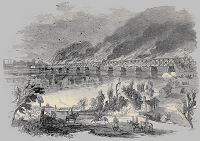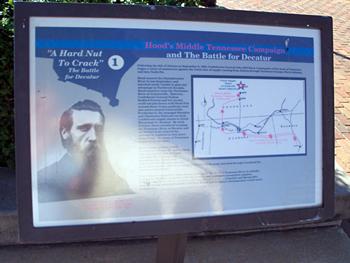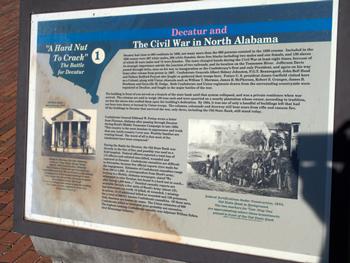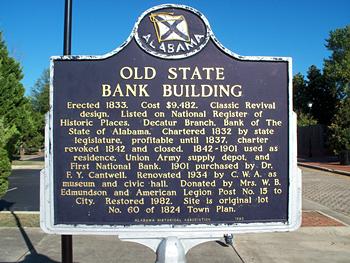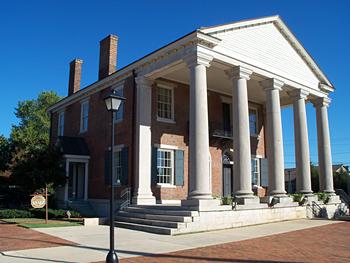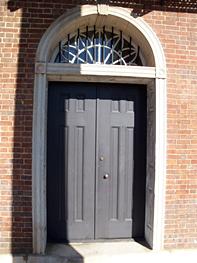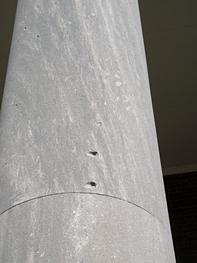|
(Sept. 2010)
Stop 01: Hood's Middle Tennessee Campaign
and the Battle for Decatur
Following the fall of Atlanta on September 2, 1864, Confederate General
John Bell Hood, Commander of the Army of Tennessee, began a series of
maneuvers against the Union line of supply running from Atlanta through
Northwest Georgia, North Alabama, and into Nashville. Hood crossed the
Chattahoochee River in late September, and marched north. Unable to gain
any advantage in Northwest Georgia, Hood turned to cross the Tennessee
River at Guntersville. However, Confederate General Nathan Bedford Forrest
and his cavalry could not join forces with Hood if he crossed there. Union
gunboats were also active around Guntersville. Furthermore, the damaged
Memphis and Charleston Railroad ran from Confederate supply depots in
North Mississippi to Decatur. By early October, Hood considered crossing
the Tennessee River at Decatur and on October 9, he ordered the railroad
be repaired to that place. Accordingly, the Army of Tennessee detoured for
Decatur. HoodÆs army arrived outside Decatur on October 26, and for three
days the small Union garrison defended the crossing with determination.
Hood soon discovered that Decatur was ōa hard nut to crack.ö On the
morning of October 30 his army marched through Courtland for Florence /
Tuscumbia. There Hood remained for three weeks, waiting for the flooded
Tennessee River to subside, waiting for Forrest to join him with his
cavalry, and waiting to accumulate supplies. When he finally moved,
frustration and failure would await at Columbia and Spring Hill, disaster
would await at Franklin, and final defeat and his army's disintegration
would await at Nashville
Enlarged Views: Hit Back Button to return |
|
(Sept. 2010)
Enlarge
Stop 01: Decatur and The Civil War in North Alabama
Decatur had close to 800 residents in 1860, not many more than the 606
persons counted in the 1850 census. Included in the 1860 census were 267
white males, 206 white females, three free blacks including two males and
one female, and 130 slaves of which 56 were males and 74 were females. The
town changed hands during the Civil War at least eight times, because of
its strategic importance astride the junction of two railroads, and its
location on the Tennessee River. Jefferson Davis passed through twice,
once on his way to inauguration as the ConfederacyÆs first and only
President, and again on his way home after release from prison in 1867.
Confederate Generals Albert Sidney Johnston, P.G.T. Beauregard, John Bell
Hood and Nathan Bedford Forrest also fought or gathered their troops here.
Future U. S. president James Garfield visited here as a Colonel, along
with Union Generals such as William T. Sherman, James B. McPherson, Robert
S. Granger, James B. Steedman and Grenville M. Dodge. Both Confederate and
Union regiments drawn from the surrounding countryside were organized at
Decatur, and fought in the major battles of the war. The building in front
of you served as a branch of the state bank until that system collapsed,
and a private residence when the war arrived. The columns are said to
weigh 100 tons each and were quarried on a nearby plantation whose owner,
according to tradition, set free the slaves who crafted them upon the
building's dedication. By 1864 it was only one of a handful of buildings
left that had not been torn down or burned by Union troops. The columns,
colonnade and doorway still bear scars from rifle and cannon fire. Of the
buildings in Decatur that survived the war, only three including the Old
State Bank, still stand today. Confederate General Edmund W. Pettus wrote
a letter from Florence, Alabama after passing through Decatur during
HoodÆs Middle Tennessee Campaign in late 1864: ōThis country is the most
desolate in appearance and truth than any [such] country I ever saw.
Wealthy families are wanting bread. The worst of all is that most of the
inhabitants have been conquered.ö During the Battle for Decatur, the Old
State Bank was directly in the line of fire, and possibly was used as a
field hospital. Federal officers reported a total loss of 113 officers and
enlisted men killed, wounded and captured at Decatur. Confederate
casualties are difficult to determine, because few official reports were
made for the engagement. Estimates of Confederate casualties range from
500 to 1,500. A correspondent from HoodÆs army, writing to a Mobile,
Alabama Newspaper, stated ōWe attempted to take Decatur, but found it a
hard nut to crack...After loosing 1,500 men..." Detailed casualty reports
are available for only a few units of Hood's army (about 1/3), but
historians can verify 12 killed, 44 wounded, 1 missing-in action, 12-15
additional killed or wounded and 139 prisoners, for a total of 208-211
known Confederate casualties. Of these men, only fourteen are known by
name. The Union estimates of 500 Confederate killed or wounded were
probably not excessive. The highest ranking Confederate casualty was
Adjutant William Sykes, 43rd Mississippi Infantry.
(Sidebar): Mungo P. Murray, 31st Ohio Infantry letter to ōDear Sister
Jennyö dated July 19, 1863 from Decatur, Alabama ōWell, I believe I have
not yet described our comfortable quarters. We are located on Broadway,
occupying one of the largest buildings in town. It is a large, two story
brick, formerly occupied by a banking house. But stop! I forgot to tell
you how many occupy this building. Well, there are two companies of the
31st, Companies H and G.ö |
